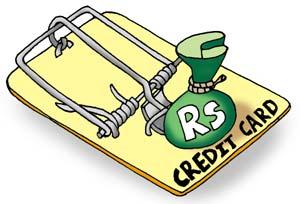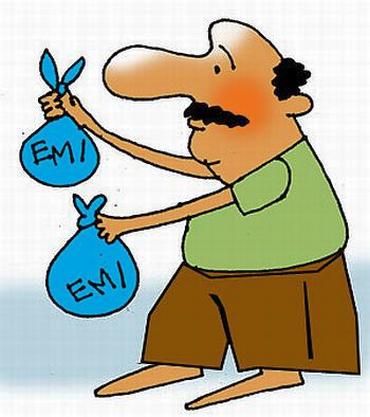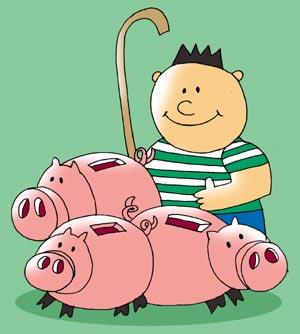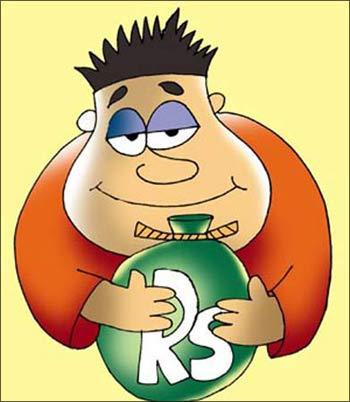Rajiv Raj
Open any wallet and you will see colourful credit cards peeping out. While credit cards are 'good to have', credit cards outstanding is certainly 'bad to owe'.
It is all too easy to spend beyond your budget with a credit card and get caught in a debt trap.
Somesh Lakhani was perpetually on the edge about his finances. He was barely managing to live from paycheck to paycheck. He had run up credit card bills he was finding difficult to repay. Hence he had been paying partial amounts -- his problems were compounding as hefty interest rates were levied upon both the outstanding amount and the fresh spending.
The feeling of despair had crept in with the monthly outstanding getting bigger and bigger.
Somesh's case is not uncommon.
So many of us get caught into debt traps and feel like we are in a whirlwind where there is no way out. There is no quick fix solution to getting out of debt.
It is only a systematic and disciplined effort that can help you free yourself from a debt trap.
Let's take a step by step approach to getting out of debt.
The author is a credit expert with 10 years of experience in personal finance and consumer banking industry and another 7 years in credit bureau sector. Rajiv was instrumental in setting up India's first credit bureau, Credit Information Bureau (India) Limited (CIBIL). He has also worked with Citibank, Canara Bank, HDFC Bank, IDBI Bank and Experian in various capacities.
Step 1: Acknowledge the problem
Photographs: Rediff Archives
The most important path to recovery is to acknowledge there is a problem and you need help to solve it.
First, get a proper understanding of all the debt you owe. A good place to start is your CIBIL Credit report. CIBIL report lists out all your loan and credit obligations and outstanding balances on each of these accounts.
Your next step is to figure out the interest rates levied on all your obligations. This will help you understand which debt you should get rid of quicker.
Most likely if you are stuck in a debt trap your CIBIL score would have taken a hit. Your aim should be getting your CIBIL score in the 750-800 range.
Please click NEXT to continue reading
Step 2: Scrutinise your alternatives
Photographs: Dominic Xavier/Rediff.com
By now you should have ideally sorted out your paperwork and have a better understanding of how much you owe and to whom. Next step is to take stock of your assets.
Assets should include your insurance policies, any fixed deposits you may have, your home and even the gold in the family.
Sometimes, the return on some of the assets is much lower than the interest that you are paying on your obligations.
Please click NEXT to continue reading
Step 3: Meet the minimum requirements
Photographs: Dominic Xavier/Rediff.com
Right now the first baby step would be to meet minimum payment requirements across all debt owed.
In the ideal world you should aim to get rid of the most expensive debt first (debt with highest interest rate) and then move on.
Some behavioural psychologists prefer a different approach -- Debt Snowball approach -- one pays off debt with the smallest balances first rather than paying the most expensive debt.
The rationale behind this approach is that one sees fewer bills as more individual debts are paid off, thus giving ongoing positive feedback on their progress towards eliminating debt.
Whichever strategy you end up choosing -- most expensive debt first or debt with smallest outstanding balances first -- you should meet the minimum payment requirements.
This is essential to avoiding defaults as a defaulted account can lead to a serious dent in your CIBIL score and your ability to take loan in the future.
Please click NEXT to continue reading
Step 4: Gather your resources
Photographs: Uttam Ghosh/Rediff.com
You must approach your larger creditors to work out beneficial agreement.
At times banks permit the credit card dues to be converted into more economic loans such as personal loans. Personal loans can be paid via EMIs without raking up hefty interest charges.
One can also raise money through alternate sources such as a loan against LIC policy, a top up loan on your existing home loan or even gold loan.
Consider liquidating assets yielding low returns for instance, if you are earning 7.5 per cent per annum in your post office account, it would make sense to liquidate it (even if there is a penal interest rate) and use the money to lower your high interest paying debt.
Please click NEXT to continue reading
Step 5: Go cash friendly
Photographs: Uttam Ghosh/Rediff.com
One of the easiest ways to reduce debt is to pay only by cash.
So lock away the credit cards till your debt has been paid and live on cash. You will find that your lifestyle takes a frugal bend without any effort.
Once you have paid off all your debt and are on top of your finances, it is recommended to pull out a fresh CIBIL report to ensure all the accounts and balances are reflected properly.
Manage the credit aspect of your finances with as much rigour as you do with the asset side of your finances to live a financially healthy life.








Comment
article